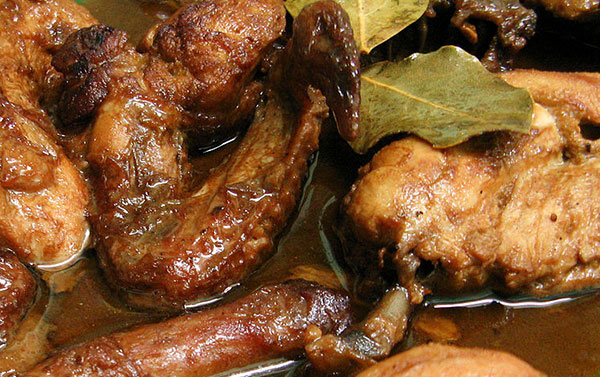Published on April 30, 2013

Southeast Asians love food and can be justifiably proud of their culinary heritages. Many of the world’s most exciting food trends have originated in the ASEAN region. The ten nations have all heavily influenced each other, and have adopted some of the best ingredients and techniques the rest of the world has to offer, most notably from China and the Indian subcontinent but also from Europe.
Despite this complexity, in this article we try to identify one dish from each country that might be considered … by some … unofficially … as the iconic national dish. The only thing we are absolutely sure of is that not everyone will agree!
Brunei Darussalam: Bruneian delicacy ambuyat (pictured above) is made by mixing hot water into starch taken from the inner trunk of the sago palm to create a thick paste. It is eaten by rolling a bite-sized piece of sticky sago paste around the prongs of a chandas, a bamboo fork, and then dipping it into a variety of sauces made from local fruits. Cacah binjai, for example, is an intense pungent sauce made from the binjai, a sour mango native to Borneo. The sauces provide the flavour. Ambuyat is also a popular dish in the neighbouring Malaysian states of Sabah and Sarawak where it is known as linut.
Cambodia:Amok trei, or steamed curried fish, is a traditional Cambodian dish often eaten during the Cambodian Water Festival, which celebrates the reversal of the Tonle Sap River. It is fish coated in a thick coconut milk with kroeung, a spice and herb paste that provides base flavours for many Khmer dishes. An important element is the addition of noni tree leaves (part of the coffee family) and the use of k’cheay (Chinese ginger or galangal). Amok is steamed or baked in a cup made from banana leaves. Local variations of the dish are popular in Lao PDR and Thailand.
Indonesia:Gado-gado is a salad consisting of boiled vegetables served with a peanut-based sauce, which is not to be confused with sate (satay). It is widely served from hawker carts, street stalls, restaurants, and hotels throughout Indonesia. Traditionally the peanut sauce is made in individual batches to suit customers’ spiciness preferences. Gado-gado is always served with krupuk (prawn or fish cracker) or some other kind of cracker. It is also often served with rice or lontong (rice cake wrapped in banana leaf).
Lao PDR: Often regarded as the national dish of Lao PDR, larb is a minced meat salad. Larb is made with raw or cooked minced chicken, beef, duck, fish, pork, or mushrooms and flavoured with fish sauce, lime juice, padaek (a condiment made from pickled or fermented fish), khao khua (roasted ground rice), fresh herbs, including mint, chilli, mint, and sometimes assorted vegetables. The dish is served at room temperature, and eaten by hand with sticky rice and raw vegetables. It is also a staple dish in the Isan region of northeast Thailand, where there is a large Lao-speaking population.
Malaysia: Malaysia’s oft-cited national dish nasi lemak is a fragrant rice dish cooked in coconut milk and pandan leaf. Ginger and/or lemon grass may be added for additional fragrance. The rich, creamy rice is almost always served with slices of cucumber, crunchy ikan bilis (small fried anchovies), roasted peanuts, a protein-rich hard-boiled egg, and sambal (spicy sauce). For a more substantial meal, nasi lemak can be accompanied by ayam goreng (fried chicken), sambal sotong (cuttlefish in chilli), chilli kangkong (water convolvulus), acar (pickled vegetables), beef rendang (a dry curry), or paru (beef lungs).
Myanmar: In Myanmar tea is eaten as well as drunk. Its lahpet or pickled tea is unique in the region. Not only is lahpet regarded as the national delicacy, but it also plays a significant role in society. In its various forms, lahpet may be served as a snack, or hold centre stage in a formal after-dinner setting as an accompaniment to green tea. No event, large or small, can be considered complete without it. Lahpet offers a unique flavour and texture to any salad. In lahpet thohk it is the star ingredient along with garlic, peanuts, lentils, tomatoes, chilli, cucumber, dried shrimp, lime, sesame seeds, and whatever salad vegetables are to hand.

Philippines: Named by the Spanish, adobo (pictured above)is a slow cooking technique indigenous to the Philippines wherein meat, seafood, and/or vegetables are stewed in a marinade of vinegar and garlic. The original name of the technique has been forgotten. Adobo is often referred to, unofficially, as the Philippine national dish, yet there is no definitive recipe. There are regional variations on the theme and even members of the same household will cook it their own way. The hearty stew is served with rice. Pic credit: dbgg1979

Singapore: Chilli crab (pictured above) is a relatively modern dish invented by Singaporean Madam Cher Yam Tian in 1950. Mud crabs are stir-fried in a sweet and savoury tomato- and chilli-based sauce. The version most popular in Singapore today was created by Chef Hooi Kok Wai, the owner of Dragon Phoneix Restaurant. He used egg white, vinegar, sambal, lemon juice, and tomato paste to create the gravy. Chilli crab is commonly served with steamed or fried mantou (Chinese buns) or baguettes to mop up the moreish sauce. Sources: Soshiok.com; “Chilli crab was created in Singapore” by Jocelyn Lee, The Straits Times, 23 Sep 2009.

Thailand: Travellers returning home from trips to Thailand have raved about tom yam (pictured above) for years. Now it is found to varying degrees of authenticity on restaurant menus all over the world. It is the most widely known of all the Southeast Asian dishes in this selection. Tom yam is characterised by its distinct hot and sour flavours provided by a broth of stock, lemongrass, kaffir lime leaves, galangal, lime juice, fish sauce, and crushed chilli. Tom yam goong (with prawns) is the most iconic version of the soup, but prawns can be substituted with any seafood, chicken, or even tofu. Lao PDR can also lay claim to tom yam, but it is travellers to Thailand who popularised it.
Viet Nam: Originating in the early 20th century, Viet Nam’s popular rice noodle soup, pho, is today a street stall staple as well as the speciality of restaurant chains. Generally sweeter in the south than in the north, pho comprises a clear broth, a few herbs, rice noodles, and meat; usually beef or chicken. Fresh herbs, vegetables, condiments, and sauces are provided on the side. The best pho broth takes hours to make; simmering beef bones, oxtail, and flank steak with spices such as cinnamon, star anise, black cardamom, coriander seed, fennel seed, clove, and charred ginger and onion. Chicken meat and bones can substitute for beef.
Unless specified, the source of the information in this article is the personal experience of the writer assisted by Wikipedia.






